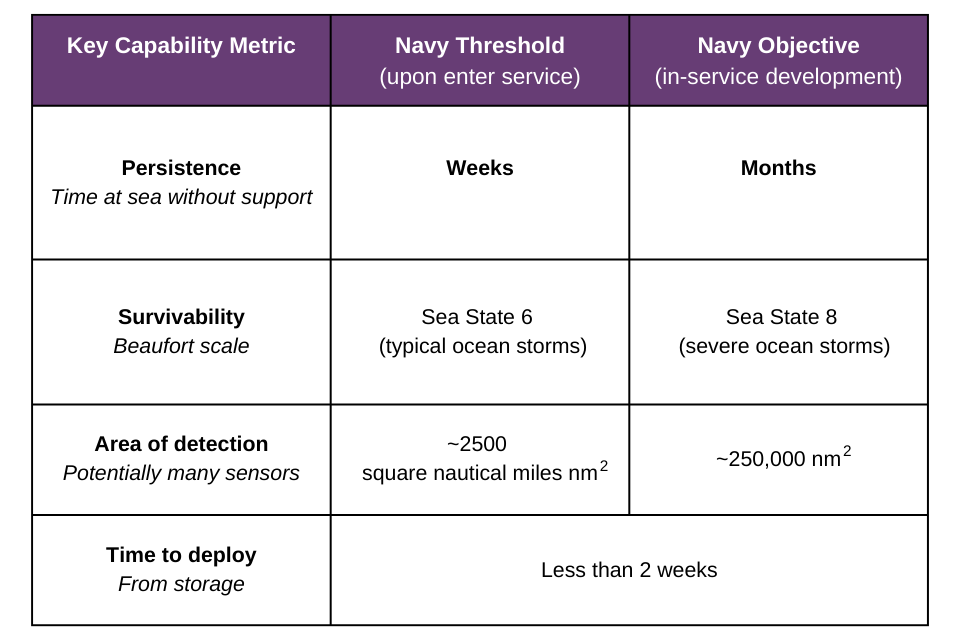Market Exploration Document: Project CHARYBDIS
Updated 18 January 2023
1. Summary
Project CHARYBDIS - anti-submarine warfare assets, is delivered by the Submarine Delivery Agency (SDA), as part of Navy Command’s Spearhead Programme. In support of this the SDA have commissioned DASA to search for innovative related technologies and sub-systems.
We are seeking submissions from across the Technology Readiness Level (TRL) spectrum. The aim of this is to build a better understanding of current market capability and potential developments to inform decisions on how best to go ahead and deliver Project CHARYBDIS. For instance, this technology engagement could inform the opportunities for disruptive future capability, the required level of modularity for future systems, and choice of interfaces. Please note that this request for information is not a commitment to any subsequent development.
2. Background
The Royal Navy seeks to maximise their operational advantage over adversaries through increasing the number of effective Anti-Submarine Warfare (ASW) assets. As part of this, Project CHARYBDIS seeks to leverage advances in autonomy, robotics and machine learning to explore new solutions beyond the current mixture of fixed infrastructure, short-term sonobuoys and high-value crewed platforms.
The project is being delivered through a phased approach, starting with establishing the evidence necessary to inform potential future development and delivery decisions.
3. What we want

We are looking for innovations (covering related technologies and systems) that could credibly result in an improvement to uncrewed anti-submarine warfare capability, focusing on the following areas:
- Sensors for underwater hostile threats, or their signature.
E.g. active acoustic, passive acoustic and non-acoustic. - Platforms including uncrewed seabed, underwater, surface and air.
E.g. Overall structures, mobility options, tethering. - Analysis including on-board uncrewed platforms, and off-board.
E.g. Data management, structuring and processing. - Communication including in-water, above-water, through surface and tethered.
E.g. associated software, firmware, hardware and integration (e.g. standards). - Launch & Recovery solutions across all domains and locations
E.g. Crewed and uncrewed options to deploy and recover systems - Power sources spanning generation, storage and transfer.
E.g. Renewables and Non-renewables. - Station-keeping and Propulsion, spanning related platforms
E.g. Tethering, Anchoring, Traditional rotary propulsion, Buoyancy systems, Biomimetics. - Navigation, including internal and external.
- Data, including collection, processing, storage, management and wiping.
- Maintenance and sustainment, options.
- Training, options including relevant simulations.
- Validation, options including test-targets.
We are seeking solutions which support achieving the Navy’s requirement ambition, with indicative order of magnitude figures provided below.

We are open to considering partial solutions at this stage.
If you require further information regarding this Market Exploration, and the wider requirement, suppliers can email [email protected] with their request. Further information will only be shared with organisations who can credibly contribute to a UK defence capability.
We welcome resubmission of previous proposals, including tailoring to this requirement and any updates since last submitted.
4. What we don’t want
We are not interested in:
- Technologies which reduce crewing of traditional platforms.
- Solutions which are limited to small scale detection and cannot be scaled up e.g. Harbour protection systems with no route to further development.
If suppliers are not sure if a proposal is within scope, please contact us using the details below.
This is not a competition and therefore we are not asking for costed proposals at this stage. This market exploration aims to provide information to the customer community to help them generate requirement criteria for potential innovations. Please note that these requests for information do not form a commitment to subsequently launch a formal DASA competition.
5. How to submit a Market Exploration Submission to DASA
Responses to this Market Exploration must be submitted via the DASA submission service, for which you will need to register. We recommend you use a Google Chrome browser to access the DASA submission service.
You will be asked for a title and short summary of your innovation, along with questions related to your organisation, your idea and technology maturity. In addition to your current TRL, please include an estimate of how long your technology will take to be implemented. We are seeking to understand what and how much further development is required for a complete solution to meet requirements, or whether a combination of separate solutions is required. The information you provide will assist in developing a statement of requirements for potential future activities.
Submissions must be submitted by midday on Friday 3 February 2023. Unfortunately, we are unable to accept any submissions after this point.
Please only provide details of one product/capability per submission. If you have several potential solutions, then please submit multiple forms.
If you have any questions or require further information regarding this Market Exploration, then please email [email protected] with “Project CHARYBDIS” in the subject line. Any further information will only be shared with organisations who can credibly contribute to a UK defence capability.
6. How we use your information
Information you provide to us in a market exploration submission, that is not already available to us from other sources, will be handled in confidence. By submitting this market exploration, you are giving us permission to keep and use the information for internal purposes, and to provide the information onwards, in confidence, within UK Government.
The MOD intends to process this information for inclusion into a wider evidence base within the CHARYBDIS Phase 1 Final Report. This will be used to inform potential future procurements, with the ability to share with allied governments through the AUKUS initiative (Australia, UK and the United States).
